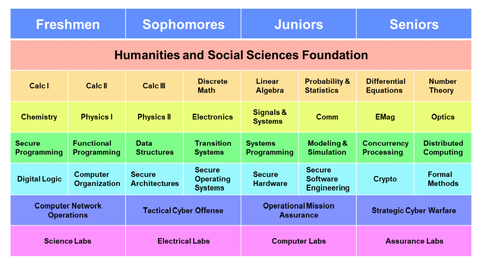NICE eNewsletter Spring 2021 Academic Spotlight
Revisiting the Need for More Bachelor of Science Programs in Cyber Engineering
By Steven Comer, Instructor, Undergraduate Cyber Warfare Training, U.S. Air Force; with support from Dr. Kamal Jabbour, Senior Scientist for Information Assurance, Information Directorate, Air Force Research Laboratory; and Dr. Marla Jabbour
The United States’ ability to defend its economic, political, and security interests depends on its ability to educate and employ Cyber Engineers, and yet this discipline continues to represent a significant gap in our education system. According to CyberSeek.org, there are more than 300,000 unfilled positions that correspond to the “Securely Provision” category of the National Initiative for Cybersecurity Education (NICE) Workforce Framework for Cybersecurity (NICE Framework). Three universities have implemented a Bachelor of Science in Cyber Engineering since the degree was first proposed by Dr. Kamal Jabbour of the Air Force Research Laboratory in 2010. Louisiana Tech University was the first to launch a program, and it provides insight into the program viability.
Since its first offering in the fall of 2012, the Louisiana Tech Cyber Engineering program has grown from an original enrollment of 23 students to 181 students today. Seventy-four students have graduated with a B.S. degree in Cyber Engineering and another 18 are expected to graduate this spring. Ninety percent of the graduates obtained either employment or admission into graduate school. Employers include CSRA, IBM, Lockheed Martin, the National Security Agency, and the Federal Bureau of Investigation.
“At Louisiana Tech, we took on this challenge to create a Bachelor of Science program that would emphasize understanding threats and vulnerabilities in the cyber[space] domain, while uniquely being equipped to design, develop, build, and test systems for secure operation,” said Dr. Miguel Gates, Program Chair for Cyber Engineering at Louisiana Tech. “The Cyber Engineering program blends the fundamentals of mathematics and physics with the design concepts of engineering and software algorithm development from Computer Science. It adds in the nuance of ethics and legislation from humanities, as well as electives in Digital Forensics, Reverse Engineering, and Applied Cryptography, among others.”
Why the Cyber Engineering Degree Matters to the U.S. Air Force
A new Air Force officer who has successfully completed a standardized Cyber Engineering undergraduate program is ideally prepared to serve in the Air Force’s Cyberspace Effects Operations career field. Officers without a degree in Cyber Engineering can thrive in this career field, but to do so and be a technically proficient leader they must play catch-up through a combination of dedicated extracurricular effort and training. The academic foundation of a Cyber Engineering graduate prepares that individual better than any other existing standardized education program, and it is a credential to be trusted at scale for recruiting and accessions efforts.
The national program must have a standardized and accredited baseline specific to Cyber Engineering, with oversight provided by the Accreditation Board for Engineering and Technology’s Engineering Accreditation Commission. The Board's Computing Accreditation Commission delivered accreditation criteria for “Cybersecurity and Similarly Named Computing Programs” in 2018. While a step in the right direction, it is not specific enough, and it mandates neither physics nor a sufficient amount of mathematics.

Implementing the Cyber Engineering Degree Program at Scale
Six steps are needed to implement the B.S. in Cyber Engineering at scale:
- Academic experts should finalize a standard curriculum. This effort will likely result in responses from academic institutions that feel they currently field programs that are “similar enough” to a B.S. in Cyber Engineering.
- Interested parties should review similar efforts underway throughout academia and determine whether this new standardized program adds enough value to be worth the effort.
- Those same leaders should appeal to the Accreditation Board of Engineering and Technology’s Engineering Accreditation Commission to begin work on the criteria for specific accreditation of B.S. programs in Cyber Engineering.
- Those leaders should provide incentives for academic institutions to implement this standardized curriculum and provide incentives (grants, scholarships, and hiring agreements) for students to enroll in the various instances of this program.
- The Final Report recently delivered by the National Security Commission on Artificial Intelligence recommends passage of a “National Defense Education Act II” to replicate the government-funded academic surges after the launch of Sputnik. If this proposed act comes to fruition, it should incorporate support for the B.S. in Cyber Engineering.
- The National Initiative for Cybersecurity Education should facilitate and encourage both the standup of this standardized program and the development of hiring pathways to appropriately vector students who choose this academic track.
For Air Force officers or anyone else seeking to fill one of the 300,000 unfilled “Securely Provision” positions in cybersecurity today, the B.S. in Cyber Engineering offers the ideal undergraduate preparation. Cyber Engineering will be the undergraduate degree of the century.
Additional Contributors:
Dr. Miguel Gates, Program Chair, Cyber Engineering, Louisiana Tech University; Justin Berthelot, Graduating Senior, Cyber Engineering, Louisiana Tech University

